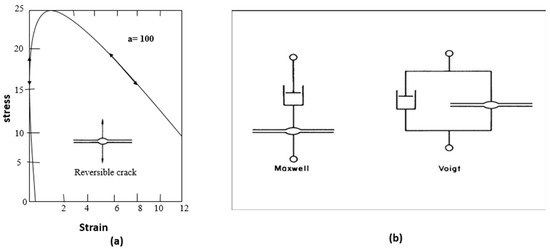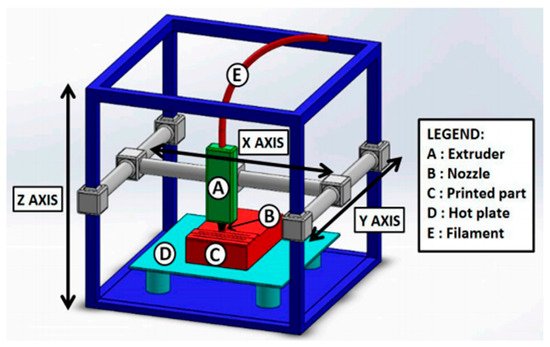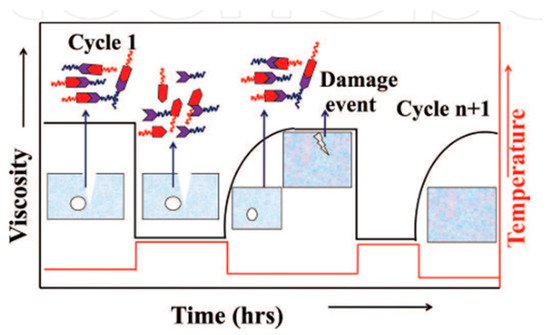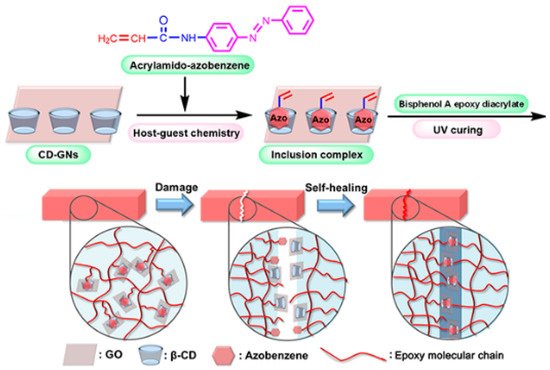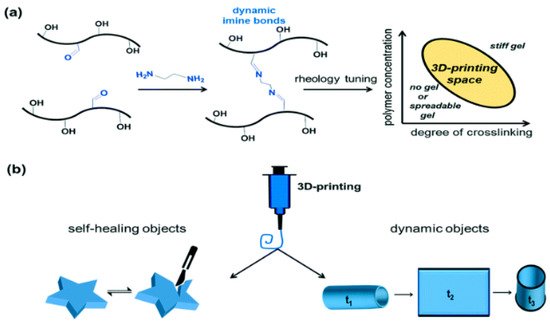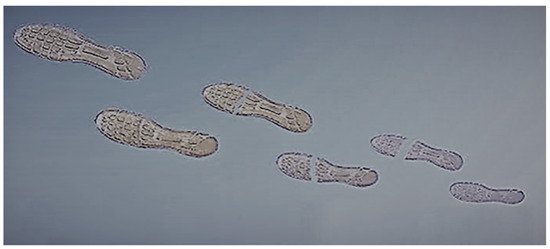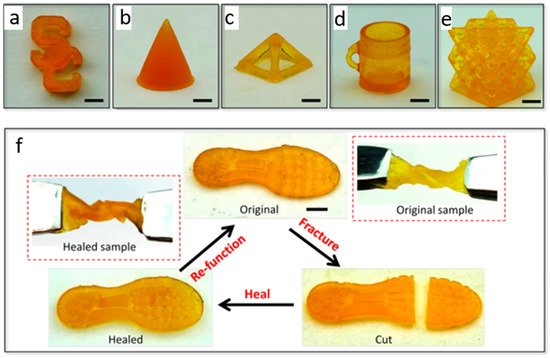Existing self-healing mechanisms are still very far from full-scale implementation, and most published work has only demonstrated damage cure at the laboratory level. Their rheological nature makes the mechanisms for damage cure difficult to implement, as the component or structure is expected to continue performing its function. In most cases, a molecular bond level chemical reaction is required for complete healing with external stimulations such as heating, light and temperature change. Such requirements of external stimulations and reactions make the existing self-healing mechanism almost impossible to implement in 3D printed products, particularly in critical applications.
1. Introduction
Self-healing materials, with characteristics that allow them to heal themselves when damaged by mechanical, thermal, or other causes, and to restore their original sets of properties, include metals, polymers, ceramics, and composites [1]. Self-healing can be defined as a natural process or mechanism, which enables the material to recover from the damages caused by, e.g., external phenomena through a healing process that returns the material to its original set of properties [2][3][4][5][6]. While natural mechanisms, such as the autonomous repair of bone, are lacking in traditional self-healing materials, the last decade has seen tremendous progress in the development and design of such materials [1]. Materials such as polymers and composites can exhibit characteristics of self-healing. If these materials are damaged, possibly due to fatigue, during their utilization, that damage can repair itself through self-healing mechanisms, which not only heal that material, but can also extend the working life of that material by maintaining its strength [1][1]. These properties are considered to be important in materials, which are more prone to damage, and where repair is not possible during the execution time.
The self-healing process in terms of materials started in the early 1970s, when the exploration of space (i.e., the Apollo mission) became a reality, and the shuttle was constructed of materials that included ammonium perchlorate-filled hydroxyl-terminated polybutadiene [7]. It was assumed at that time that materials could be damaged at the nanoscale, and that would lead to larger microscopic cracks, causing the catastrophic loss of not only materials, but also payloads. It became clear later that such damage could be self-healing.
First, damage can be measured through mechanical stress-strain, to quantify the damage and effect of self-healing methods [8]. This was known as a reversible self-healing crack, which was used later to assess the basic characteristics of self-healing elements, using, for example, the Maxwell and Voigt models [7]. below shows the first self-healing mechanism element, which was further improved.
Figure 1. (
a) The stress–strain response of a healing element is shown where the two parallel surfaces interact, modelled by an anharmonic non-bonded potential function. (
b) Viscoelastic elements composing the healing element, in series (Maxwell) and in parallel (Voight). (Reproduced with permission) from
[7]. Copyright: from The Royal Society of Chemistry, 2008. Figure above shows the reversible self-healing crack with basic phenomena of idealized element of self-healing, used in parallel or series with dashpots and elementary springs to the Maxwell or Voigt models, which shows yielding at critical strain.
Since, 1970, there have been a significant number of publications on self-healing mechanisms of different materials, especially thermoplastic and cross-linked systems. However, it was 2001 when the first article on the self-healing in polymer-based materials was published in Nature [7]. This triggered research into the use of self-healing polymer materials, inspired by the tremendous advantages of self-healing materials over traditional materials in engineering applications, such as electrical, automotive, biomedical, aerospace, chemical, and civil [9].
Smart polymer materials have similarities to biological self-healing phenomena, and have significantly improved the life of critical components [7][10]. The development of these kinds of systems and materials is challenging, but not impossible, and include self-healing paints and coatings, even bridges, buildings and cars [2][11]. Smart materials are often used in critical applications and components, to make sure the products have durability, flexibility, and are lightweight. Such materials are required to self-heal after damage. For example, presently, if a scratch is found on the paintwork of a car, it requires either expensive corrective work in a repair shop, or a significant and inconvenient repair by the owner. In such a situation, a self-healing process that ensures that the relevant material maintains its function is highly desirable, particularly if it retains its ability to reverse damage over a long time, and without delay. It would be doubly advantageous for the self-healing process to cure damage automatically without any peripheral intercession [4][5][12][13][14].
Most materials change their properties with age, and gradually decay. Some materials take longer than others; wood rots when insects or micro-organisms eat it away; however, plastic can take hundreds of years to break, or sooner with the help of fire or sunlight [9]. Some materials are very vulnerable and sensitive to breakage and sometimes very unexpectedly, such as when applied force (e.g., stress and strain) generates internal fractures. Such materials pose the hardest challenges in terms of the self-healing process [15]. With regular maintenance and inspection, it is easy to spot such problems as rotting or rusting; however, there can be cracks in crucial components where they are hard to detect, such as inside hot engines that operate at high speeds with spinning blades. There are technologies and techniques, which can be used to detect such faults, e.g., the well-known non-destructive testing technique of ultrasound scanning, that makes it relatively easy to find defects within materials or components during routine inspections. However, when the component is in use, it is almost impossible to detect a potential failure.
The mechanics of these challenges have become more complex with recent advancements in the design and manufacturing of polymer-based components [10][16]. For example, the mechanical behaviour of a component at microstructural level changes if it is manufactured using the additive method of manufacturing, rather than a conventional method [17]. In the past, self-healing mechanisms were devised for components made of conventional methods materials, but additive manufacturing (AM) offers important opportunities to include into the object means for self-repair [18].
However, polymer materials are considered to have highly self-healing and elastic properties, along with being a challenging task. A study from Zhao et al. found that with the use of 4-tris as a tetratopic linker to crosslink a poly(dimethylsiloxane) backbone,, one can obtain a self-healing polymer, with efficient outcomes upon stretching. It was also revealed that materials with strain at the break of material, such as polymers, recovered to their original length after being stretched [19]. The damaged material was also healed at room temperature—up to 93% within 1 h. Zhao et al. suggested that polymers can be used in different applications, like electronic sinks, biochips, matrixes in soft actuators, and others.
2. Existing Self-Healing Mechanisms in 3D Printed Structures
2.1. 3D Printing of Self-Healing Materials
The use of 3D printing has become increasingly ubiquitous across industries, as the ability to generate user-defined 3D objects with a wide diversity of materials has developed
[20][21]. Evidence shows that 3D printing technologies can have a huge impact on the different sectors of business, because it can move a business from traditional processes to new innovative procedures, with a more sustainable business model
[21][22]. However, sometimes, such a move can prove to be riskier as well, because there will be a significant amount of investment needed before moving toward innovative technologies or adopting the core business
[3]. Despite this fact, evidence also revealed that moving to 3D technology is considered less risky than any other innovative technologies, because it allows firms to produce products or services based on customer demands, with minimum costs, as shown in
[22].
Figure 2. Three-dimensional printing effective interlinking between different components of the business environment. (Adapted from
[22]).
The self-healing process allows for the reduction of operational costs, and makes a self-healing mechanism more effective, as discussed earlier. The concept of self-healing mechanisms and 3D printing can make a significant difference and provide advantages. According to both the University of Southern California and University of Connecticut, materials with self-healing have added advantages in terms of the rapid manufacturing process using 3D printing technologies
[22][23]. In 3D printing, the materials are manufactured using a photo-polymerization-based 3D printing technique, which uses a process that relies on light to solidify a liquid resin—in which it is essential to maintain the right ratio between the different chemical groups to control the materials’ characteristics. Yu and colleagues have discussed the process of the 3D printing of self-healing materials, such as 3D-printed rubber materials, which can repair damage to themselves
[24].
The process of 3D printing is both AM and rapid prototyping, and involves the joining of materials to create objects based on data modelled in 3D, generally in multiple layers
[25]. Moreover, 3D printing consists of various AM techniques that allow the rapid yet flexible fabrication of complex 3D structures, with different characteristics from the sub-micron to the multi-meter scale
[26]. There has been extraordinary progress in the basic and applied knowledge, related to the structure and treatment of 3D printing, and its characteristics, yet many gaps remain
[27]. Three-dimensional printing is an emerging technology that can be used to produce complex geometries directly, which are otherwise next to impossible to manufacture. Instead of adopting the traditional manufacturing processes
[28], including molding, machining, and assembly, these steps are streamlined into a single process that greatly enhances design flexibility
[29][30].
Many studies have discussed different polymers and mixtures for widely used printing technologies, such as FDM, SLA, and SLS. Limitations on producing self-healing 3D printed components are mainly due to the need to understand each polymer’s characteristics and limitations
[31][32]. Moreover, more control needs to be taken when setting up the printer before sending a file to the printer
[33]. Besides, a dual extruder FDM, see , may be necessarily to integrate self-healing polymers within the 3D printed components
[34].
Figure 3. Typical fused deposition modelling (FDM) setup. (Reprinted with permission from
[35]. Copyright Wiley Interscience, 2019).
2.2. General Categories of Self-Healing Mechanisms Applicable to 3D Printed Structures
Self-healing mechanisms of polymer structures can be classified into two broad categories: intrinsic and extrinsic
[10]. For the extrinsic approach, healing agents are sequenced through the main matrix, planted in microcapsules
[36][37][38][39], or a 3D vascular network of hollow fibers
[32][33] and channels
[10][40][41][34], though it should be noted that the quantity and amount of transmission of the healing precursor are somewhat restricted
[10]. External microcapsule layers and vascular walls are subjected to stress, when crack growth takes place and ruptures, and releases the healing agents that either react with each other or interact with the matrix to seal the crack
[27]. Stiff polymer products can be incorporated, since the molecular diffusion of the matrix is not a prerequisite
[21][37], and for other practical applications, extrinsic self-healing has opted to make use of hard polymer structures
[42]. The correct option for a self-healing procedure will vary with nature and location of the likely damage, the chosen repair resin, the operational environment, the proximity size of the damaged zone, and the healing precursor container
[41].
The intrinsic approach relies solely on the inherent capacity of the materials, and comes into action through reversible covalent bonding
[43][44][45] and supramolecular interactions
[46][47]. To overcome the restrictions and concerns of the extrinsic approach, several intrinsic healing systems are now available. These are tailored to provide multiple healing sites during macroscopic damage
[42]. shows the dynamic strategy of damage acceptance and management
[41][39].
Figure 4. The concept of damage healing with the intrinsic approach. (Reprinted with permission from
[41]. Copyright InTechopen’s, 2019).
An ongoing research study conducted on intrinsic self-healing of covalent polymers focusing on bond scission and reconnection has shown remarkable progress. The most prominent of these studies relates to the Diels–Alder (DA)-bond aided self-healing mechanism
[38][43], which has been modernized and improved because of the adoption of different perspectives. Some primary works targeted varied reversible chemistries, such as the disulfide bonds, living silicon dynamic exchange of C–C bonds
[44], and reversible C–ON bonds
[48][47]. These studies were important in the development of intrinsic self-healing reversible covalent bond materials, thereby making available a greater number of options for specific needs, having stronger C–C bonds and multi-functional S–S bonds, as shown in
[45][49]. In addition to these, thiolene chemistry and pH-sensitive reversible acylhydrazone bond are still to be adopted in intrinsic self-healing of damage for the restoration of mechanical properties in structural materials
[47][50][51]. To provide customized solutions for practical purposes, a much greater emphasis is needed on such topics as the reproducibility of healing results, minimizing dependence on external stimuli, providing self-healing to a particular engineering material and, to ensure complete satisfaction and confidence, the preservation of the original material, with structural flexibility and integrity during crack healing.
Figure 5. Schematic illustration of the self-healing mechanism of epoxy composite films. (Reprinted with permission from
[49]. Copyright American Chemical Society, 2018).
2.3. Healing Mechanism for Different Material Classes
Different materials are used in 3D printing processes, including polymers, metals, and composites that have self-healing mechanisms. This means that 3D printing has an impact on how products are built, delivered, and designed. Moreover, the traditional economies of scale offered by traditional manufacturing are no longer so important.
The dependency of the required conditions, as discussed, is mainly on the nature and characteristics of materials. For metals, the desired mobility needs to be induced by increasing the temperatures to more than 800 °C. To obtain healing effectively in various types of materials, different mechanisms, each with their own strategy, are taken into consideration. As such, the encapsulation process has been adopted for various materials in a general healing approach, whereas reversible cross-link is designed for special cases related to polymers only
[52][53]. shows the mechanisms, materials and strategies for different options and classes of materials.
Table 1. Healing mechanism for different materials; the symbol indicates the expected or demonstrated level of success (tick for applicable and cross for not applicable).
| Mechanisms |
Type of Materials |
Name of Materials |
| Polymers & Polymer Composites |
Metals |
|
| Encapsulation |
✓ |
|
Polycarbonates, cement, ABS, poly(urea-formaldehyde) and polystyrene |
| Increase of temperature |
✓ |
✓ |
Glass, aluminium |
| Expanding phases |
✓ |
✓ |
powder or slurry |
| Separation phases |
✓ |
|
Ionomers, epoxy |
| Reversible crosslinks |
✓ |
× |
Diels-Alder reactions, polycyclopendiene |
| Channel transport |
✓ |
|
PLA (Polylactic Acid) |
| Biological processes |
|
× |
Polyurethane (PU) |
| Electro-chemical process |
× |
✓ |
Polycarbonates, polyethylene, plastic |
Comparatively less investigation has been made in terms of self-healing characteristics for metals
[54]. As the healing action in metals requires mobility and higher temperatures and this poses the greater challenge of incorporating higher temperatures into the design phase, self-healing metals are categorized as nano-scale voids and macro-scale cracks
[55], depending on the dimensions of the healed damage
[56][57]. In contrast, concretes have an inherent ability to heal themselves, because of the distributed presence of hydrated and un-hydrated particles for the dissolution and carbonization of calcium hydroxide. These can heal smaller cracks, and restrict crack width, thereby restricting the damage at a later stage, which can also be healed. Besides, water acts as an agent for hydration and calcium hydroxide dissolution, that crystallizes when reacted with carbon dioxide. Multiple types of research has been conducted on the natural ability of such materials to self-heal. To reduce the propagation of a crack, some cementitious composites have been designed, with the addition of the reinforcement of fibers.
Polymer materials with reduced melting points or in liquid conditions are frequently utilized in the 3D printing sector as a result of their minimal weight, minimal cost, and flexible processing abilities
[46]. While the geometry of 3D printed polymer objects could be significantly complex, their insufficient mechanical robustness and functionality represent considerable obstacles in terms of broader applications
[58].
2.4. Focused Efforts Made for Developing Self-Healing in 3D Printed Structures
This section discusses, in detail, the effort made for developing self-healing in a 3D printed structure, including working principles and advantages, with visual evidence.
2.4.1. Working Principle
Nadgorny and colleagues researched the 3D printing of self-healing gels, to understand recovery from mechanical damages
[27]. The study presented the working principles of 3D printable, self-healing gels, as shown in , with the following stages.
Figure 6. Schematic workflow for a 3D printable, self-healing working principle. (
a) The first stage includes the synthesis and functionalization of PHEMA with pendant benzaldehyde groups, followed by a cross-linking with a diamine. The preparation of printable inks requires a delicate rheological tuning of ink formulations, and a mapping of the printability space. (
b) After the optimization study was accomplished, selected formulations, which demonstrate a good balance between flow and self-support capabilities, were 3D-printed. The objects dis-play self-healing and dynamic properties. (Reprinted with permission from
[27]. Copyright Royal Society of Chemistry, 2017).
-
The first step comprises the synthesis and functionalization of PHEMA (benzaldehyde-functionalized poly-2 hydroxyethyl methacrylate) with the pendant benzaldehyde group; next, cross-linking with diamine takes place. A delicate rheological tuning of ink formulations and the mapping of printable space is required to prepare printable inks
[59].
-
After the optimization, the study achieved good outcomes, showing a balance between self-support capabilities and the flow of 3D printed gel. Finally, the objects displayed self-healing and dynamic properties
[60][61].
A self-healing 3D printed shoe pad was developed by Xin and Yu
[62], using photo-polymerization-based 3D printing, a process that uses light to solidify the polymer into a particular shape, as shown in .
Figure 7. Severed 3D-printed shoe pad self-healing itself. (Adapted from
[23]).
A team from the University of Southern California experimented on additive manufacturing of the self-healing elastomers mechanism, which can be used for 3D printing, as well as 3D architecture and the self-healing of fatal fractures
[63][23]. The mechanism relies on the molecular structures of photo-elastomer ink. Furthermore, the experiment used projection micro-stereolithography systems with various 3D complex geometries printed at a fast rate, e.g., 0.6 mm × 15 mm × 15 mm/min = 13.5 mm
3/min. The main purpose was to consider how rapidly a fracture healed, and the original structure and mechanical strengths were restored. A model of the photo-elastomer in terms of the self-healing process was compared with a theoretical polymer-network-based model, and with experimental results. The self-healing materials contained both conductive and dielectric phases, and can be produced using a rapid photopolymerization capability, available with various AM systems, such as self-propagation photopolymer waveguide, PolyJet printing, stereolithographic, and two-photon lithography
[64]. However, the proposed self-healing photo-elastomer system was considered a new and efficient self-healing mechanism, and suitable for 3D printing
[65].
The experiment used 3D-printable self-healing elastomers with a soft actuator, which can lift a weight ten times its own weight, and with the feature of restoring toughness to over 90% after fracture
[66]. The materials were used without purification, and included Vinyl-terminated polydimethylsiloxanes and dimethylsiloxane (MMDS), ethanol, sudan I (photo absorber), toluene, Iodobenzene diacetate (IBDA), phenyl-bis, and phosphine oxide diacrylate (HDDA). A computer-aided design (CAD) model was used for fabricating the multi-material structure, and with an image sequence prescribed, spanning the vertical direction in the experiment, as shown in the images in
[63].
Figure 8. (
a) The molecular design of the self-healing elastomer, where self-healing features and photo-polymerization were integrated with a self-healing elastomer based on the disulfide (R-S-S-R) and coexistence of thiol (R–S–H), through harnessing the high-rate and high yield thiol-ene crosslinking reaction to achieve the photo-polymerization. (
b) the CAD model using image sequences to perform additive manufacturing to achieve efficient samples through radical initiation. (
c) the process further goes into self-healing by harnessing dynamic disulfide bonds through reactions (disulfide) to bridge the fractured interface, as shown. The experiment was conducted with high efficient oxidant, iodobenzene diacetate (IBDA). (Reprinted with permission from
[63]. Copyright NPG Asia Materials and creative commons, 2019).
In this experiment, the molecular design of the self-healing elastomer was one which can be used in 3D printing
[65], and other applications as well.
An image sequence as shown above was sliced through the CAD model, with a fixed distance between each layer. The images were projected onto the resin bath, layer-by-layer, to give the final shape its structure. The self-healing process was enabled by a disulfide bond, and the fractured interface can be healed by the metathesis reaction of disulfide. The manufactured samples (i.e., 3D printed), circular cone, pyramid lattice, cup, and others, are shown in the figure. In terms of the self-healing process, the sample shoe pad could sustain a twist of 540 degrees. If the shoe pad was cut it, in 2 h, the healing process, at a temperature of 60 °C, returned the pad to its original shape, with properties similar to the original sample
[63][67]. It was claimed that using 3D printing helped to make the product faster to manufacture, and more durable.
Figure 9. Manufacturing samples used to test self-healing mechanism with using shoe pad sample. (
a) A logo of the South California University, (
b) circular cone, (
c) pyramid lattice, (
d) cup, and (
e) an octet truss lattice. (
f) Self-healing of a shoes pad sample. (Reprinted with permission from
[63]. Copyright NPG Asia Materials and creative commons, 2019).
2.4.2. Self-Healing Mechanism Advantages and Limitations
The self-healing mechanism, as obtained in 3D printed structures, has the advantages associated with 3D printing: reduced time to production, cost-effectiveness, environmentally friendly, and versatile, as almost anything that can be imagined can be produced [18]. Nevertheless, self-healing in a 3D printing structure can lead to strain release that subsequently initiates cracks that can propagate and damage the material [68][27][32][37][69][70]. However, the self-healing properties are capable of overcoming potential damage at the sub-surface level, thus allowing cracks to be healed rapidly, with no impact on the workability of the component, thereby significantly reducing vulnerability. However, because of its high customizability and capability to print complex geometries, researchers commonly use 3D-printing [71]. Additionally, a recent development in CAD software [10] and novel materials [72] further extends their 3D printing capabilities, especially for self-healing mechanisms.
There are significant limitations that exist on both the self-healing mechanism and the exploration of the study domain. Evidence shows that most of the investigations have been conducted on how could different materials can be made more damage tolerant; less research has been conducted on how materials heal the damage within the perspective of 3D printing [18]. There are many materials, such as polymers and polymer-based composite materials, that can suffer from different types of cracks, and which can lead to more severe or catastrophic damage: these are both external (e.g., environmental attacks, etc.) and internal (e.g., quality of materials, etc.) [65]. This omission is considered as a gap in the research into self-healing as applicable to 3D printing. More research needs to be conducted in this area. The limitation, in terms of self-healing for 3D printing, is cost, because more of the catalyst is required to achieve a higher degree of healing [73][74].

